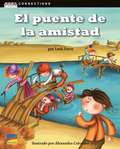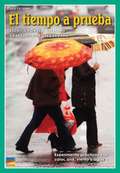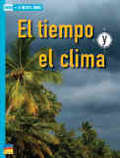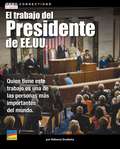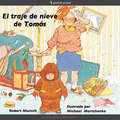- Table View
- List View
El poderoso Misisipi (¡Arriba la Lectura!. Level I #8)
by Patricia KummerEl Misisipi es un río poderoso. Lee este libro para saber más. NIMAC-sourced textbook
El poderoso roble (¡Arriba la Lectura!, Level J #1)
by Lisa Trumbauer Vicki JacobsonNIMAC-sourced textbook
El proyecto de la piscina (¡Arriba la Lectura!, Level P #74)
by Lesley Vamos Marg McAlisterNIMAC-sourced textbook. Lincoln tiene una idea genial para celebrar su cumpleaños: ¡una fiesta en la piscina! El único problema es que… no tiene piscina. ¿Cómo hará para convencer a sus padres de construir una piscina a tiempo para su cumpleaños?
El pájaro dorado (¡Arriba la Lectura!, Level T #85)
by Jim Howes Alexandra BallNIMAC-sourced textbook
El ratopín desnudo se viste (¡Arriba la Lectura!, Read Aloud Module 2 #3)
by Mo Willems F. CampoyNIMAC-sourced textbook
El regreso del lobo (¡Arriba la Lectura!, Level S #19)
by Margaret Su Bradley ClarkWen no se siente nada cómodo al llegar al campamento de observación de lobos. Le parece que no encaja bien con sus compañeros. Cuando el grupo queda atrapado en una tormenta, Wen pone en práctica sus habilidades especiales para salvarlos a todos. NIMAC-sourced textbook
El rescate de Maraña (¡Arriba la Lectura!, Level I #2)
by Misha Herenger Jan LiefferingEl gato Maraña necesita un hogar. ¿Logrará llevarse bien con Bruno? NIMAC-sourced textbook
El rescate del conejillo de Indias (¡Arriba la Lectura!, Level L #55)
by Pamela Rushby Sarah DavisLulú, Ajay y Darcy se sorprenden al saber que el año pasado se rescataron muchos conejillos de Indias y que aún viven en la clínica veterinaria de la tía Elly. ¡Cincuenta conejillos de Indias necesitan un nuevo hogar! ¿Qué pueden hacer Lulú, Ajay y Darcy para ayudar? NIMAC-sourced textbook
El rey de Egipto (¡Arriba la Lectura!, Level R #54)
by Diana Platt Pam RushbyNIMAC-sourced textbook
El río Misisipi (¡Arriba la Lectura!, Level N #43)
by Annette SmithNIMAC-sourced textbook. ¿Sabías que el río Misisipi es uno de los más largos de América del Norte? ¿O que Mark Twain y otros escritores famosos escribieron muchas historias sobre él? Descubre todo sobre el Misisipi y sobre cómo este río imponente influye sobre las vidas de las personas que viven cerca de él.
El secreto – Libro 1: Cuidado con la magia (El secreto #1)
by Katrina Kahler Aranzazu SánchezCuando Tess, una chica de 12 años, se muda a un nuevo barrio, intenta hacerse amiga del chico que vive en la casa de al lado, que tiene la misma edad y se llama Sam. Tess ignora que Sam tiene un poder especial, un poder que debe mantener en secreto cueste lo que cueste. No, no puede leer la mente, pero es capaz de otra cosa que a veces le cuesta controlar. Los otros chicos piensan que es raro y lo intentan evitar, pero con la llegada de Tess, todo cambia. No obstante, Sam no es el único que siente interés por Tess. El chico más popular del curso, Jake Collins, comienza a interesarse por ella y Sam decide que ya no tiene esperanza alguna. Entonces, cuando los abusos de Jake empeoran, Sam se ve obligado a enseñarle una lección. Pero, ¿qué pasa si Sam llegase demasiado lejos? ¿Y si Tess descubriese de lo que es capaz? Si te gustan las lecturas sobre niños con poderes especiales y si te gustó mi colección Telépata, estoy segura de que también disfrutarás de esta colección. Es otra emocionante historia repleta de drama, suspense, romance, rivalidades, amistad y mucho, mucho más. Un libro lleno de suspense para chicas que no querrás dejar de leer.
El secreto – Poder de la Mente Libro 3
by Katrina Kahler Betty SerranoEl secreto – Poder de la Mente, Libro 3. Este libro fue especialmente escrito para chicos y chicas de 9 a 12 años, de habla hispana en America y España
El señor Lawson tiene razón (¡Arriba la Lectura!, Level T #83)
by Pamela Rushby Nathalie OrtegaNIMAC-sourced textbook
El sueño de Danny (¡Arriba la Lectura!, Level O #13)
by Jack Gabolinscy Karen OppattNIMAC-sourced textbook
El sueño de Emmanuel: La verdadera historia de Emmanuel Ofosu Yeboah (¡Arriba la Lectura!, Read Aloud Module 5 #4)
by Laurie Thompson Sean QuallsNIMAC-sourced textbook
El tiempo y los animales (¡Arriba la Lectura!, Level C #56)
by Melissa BurkeNIMAC-sourced textbook. ¿Qué hacen los animales cuando llueve, nieva y sopla el viento? ¡Lee y lo sabrás!
El traje de nieve de Tomás
by Robert Munsch Michael MartchenkoTomás se niega a ponerse su traje de nieve a pesar de las súplicas de su madre, su maestra y hasta el director de la escuela.
El traje nuevo del emperador: Cuento de Hans Christian Andersen (¡Arriba la Lectura!, Level K #88)
by Doug Roy Robina WillsonDos tejedoras engañan al emperador y a sus ministros. Lee el cuento de hadas y la obra de teatro para saber qué pasa con el emperador. NIMAC-sourced textbook

